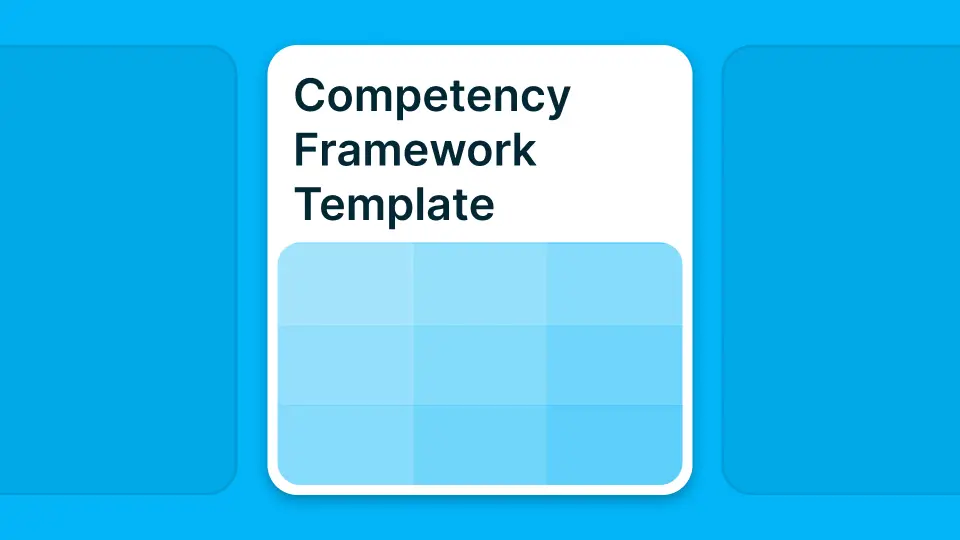Your HR department is scaling fast—new hires, fresh responsibilities, evolving compliance demands. Yet when you try to map who knows what, you hit a wall. Spreadsheets are outdated. Job descriptions are vague. And no one's quite sure if your payroll specialist can handle GDPR audits or if your recruiter has the skills to lead employer branding campaigns.
Here's the truth: 68% of HR leaders admit they lack a clear view of their team's skill gaps—despite pouring resources into talent development. The fix? A structured, role-based hr skills matrix templates that turns guesswork into objective data. This guide hands you downloadable hr skills matrix templates for every HR function—from HR Ops to People Lead—plus competency frameworks, proficiency scales, calibration workflows, and real-world examples from companies at 50, 200, and 500+ employees.
You'll discover:
- Ready-to-use Excel, Google Sheets, and Notion templates for all core HR roles
- Competency families mapped to each level—including DACH-specific notes on Works Council and GDPR
- Behavioral proficiency scales (0–4 or 1–5) with evidence fields for objective assessment
- Why most matrices fail—and the actionable fixes that drive adoption
- How Sprad's 32,000+ skills taxonomy and Atlas AI automate gap identification and reduce manual effort by 60%
Let's dive into building a matrix that actually gets used—starting with why your team can't afford to skip this step.
1. Why Every HR Team Needs a Role-Based Skills Matrix
An hr skills matrix template is the only way to gain an objective, real-time view of strengths and gaps across your entire HR department. Without it, you're flying blind—making hiring decisions on hunches, promoting based on tenure instead of capability, and letting critical compliance risks slip through the cracks.
Research backs this up. LinkedIn's Workplace Learning Report found that companies using structured skills frameworks are 24% more likely to meet their growth goals. Why? Because they know exactly where to invest in development, who's ready for leadership, and which skills are missing before problems escalate.
Take a global SaaS scale-up with 200 employees. They introduced a tailored matrix for their HR team and uncovered a glaring gap: no one had advanced payroll compliance expertise. Within one quarter, they upskilled two HR Ops specialists through targeted training. The result? A clean audit and zero regulatory findings—something they'd failed to achieve the previous two years.
Here's how to make your matrix work:
- Map out all key HR roles before you build—don't skip niche functions like People Analytics or Employer Branding
- Involve stakeholders from each team for accurate competency identification—your recruiters know sourcing skills better than you do
- Link matrix data directly to career paths and development plans so it's not just a static document
- Schedule regular reviews—quarterly for fast-growth companies, annually for stable enterprises
- Use evidence-based proficiency ratings instead of gut feel or manager favoritism
A simple comparison table shows the difference between guesswork and structure:
| Role | Core Competency | Current Level | Target Level |
|---|---|---|---|
| Recruiter | Sourcing Techniques | 2 | 4 |
| HR Ops | Payroll Compliance | 1 | 3 |
| L&D Specialist | Facilitation Skills | 3 | 5 |
Best practice: Sync your skills matrix with performance review cycles. When managers see skill gaps during quarterly check-ins, they can act immediately instead of waiting for year-end chaos. This integration also ensures your matrix stays relevant—it becomes part of the workflow, not an HR pet project gathering dust in a shared drive.
Now that you understand why a role-based matrix is non-negotiable, let's look at what goes inside one—and how downloadable templates can save you weeks of manual work.
2. Downloadable HR Skills Matrix Templates by Role and Level
Pre-built templates save time and ensure consistency—but only if they're tailored for each HR function and seniority level. A generic "HR skills" spreadsheet won't cut it when your Recruiter needs sourcing and interviewing competencies while your Payroll Admin requires deep knowledge of employment law and GDPR compliance.
According to Josh Bersin Academy, standardized templates reduce implementation time by up to 40%. Instead of building from scratch, you customize proven frameworks—adjusting competency families, proficiency scales, and evidence fields to match your org's structure.
An e-commerce company with 500 employees used a downloadable Google Sheets template for their Employer Branding and Recruiter roles. The template included pre-populated competencies like "Candidate Relationship Management," "Diversity Sourcing," and "Employment Branding Strategy." They customized the proficiency scale to reflect their hiring volume and added DACH-specific compliance notes. Within two weeks, they onboarded new hires faster and identified high-potential staff for promotion—something their old manual process couldn't deliver.
Here's how to choose and customize the right template:
- Pick the format that fits your tech stack—Excel for offline work, Google Sheets for real-time collaboration, Notion for integrated project management
- Customize columns for role-specific competencies like GDPR knowledge for DACH teams or DE&I expertise for Employer Branding roles
- Embed proficiency scales (0–4 or 1–5) with behavior-based anchors so ratings aren't subjective
- Add "evidence" fields where managers document real-world examples—completed projects, certifications, observed behaviors
- Version-control your templates as roles evolve—tag updates with dates and reasons for changes
Different roles demand different templates. Here's a breakdown:
| Template Format | Best For | Sample Competencies |
|---|---|---|
| Excel | Payroll/HR Ops | Payroll Law, Data Entry, Benefits Administration |
| Google Sheets | Recruiter/TA | Sourcing, Interviewing, ATS Management |
| Notion | People Partner/HRBP | Change Management, Coaching, Employee Relations |
| Excel + Macros | People Analytics | Dashboard Creation, SQL, Reporting |
For maximum impact, link your templates to internal resources. If you're building skill frameworks, reference your career pathing documentation. If you're tracking gaps, connect to individual development plans so employees see how matrix assessments translate into growth opportunities.
Quick tip for DACH teams: Include columns for Works Council collaboration and GDPR handling. These aren't just compliance checkboxes—they're business-critical skills that separate junior HR Ops roles from senior HRBP positions. Make sure your proficiency scales reflect local legal requirements, not just generic HR theory.
Next, let's break down what actually goes inside these templates—the competency families that drive modern HR success.
3. Building Competency Families for Modern HR Teams
A robust hr skills matrix template doesn't just list "HR knowledge" or "communication skills." It maps detailed competency families tied directly to business impact. Without this structure, your matrix becomes a vague wishlist instead of a strategic tool.
SHRM research shows that organizations with clearly defined competencies have 33% better retention rates. Why? Because employees see transparent paths for growth. They understand which skills unlock promotions, which gaps hold them back, and how their development aligns with company goals.
A fintech startup scaling from 50 to 200 staff created distinct competency tracks for DE&I, onboarding experience, and employee relations. Before the matrix, L&D priorities were reactive—whoever complained loudest got training budget. After mapping competencies, they allocated resources based on actual gaps. The result? A 28% drop in early-stage attrition and faster promotion cycles for high performers.
Here's how to build competency families that stick:
- Group competencies into logical families—recruiting/sourcing, DE&I, analytics/reporting, legal/compliance, employee relations, etc.
- Assign unique behavioral indicators per family so "GDPR handling" looks different from "interview facilitation"
- Involve subject-matter experts when defining advanced-level behaviors—your People Analytics lead knows dashboard skills better than a generalist HR manager
- Update regularly as new tools and processes emerge—AI in recruiting, skills-based hiring, and remote onboarding weren't priorities five years ago
- Include DACH-specific categories like Works Council collaboration (BetrVG) and data protection compliance for German, Austrian, and Swiss teams
Different roles lean on different families. A Recruiter needs deep expertise in sourcing and interviewing but basic knowledge of payroll law. An HR Ops specialist flips that priority. Here's a quick reference:
| Competency Family | Sample Skill | Relevance by Role |
|---|---|---|
| Employment Law/GDPR | Data Privacy Handling | Payroll Admin, HR Ops, HRBP |
| Recruiting/Sourcing | Boolean Search Techniques | Recruiter, Talent Acquisition Lead |
| DE&I | Inclusive Hiring Practices | Recruiter, Employer Branding |
| Analytics & Reporting | Dashboard Creation | People Analytics Specialist |
| Employee Relations | Conflict Resolution | HRBP, People Manager |
| Change Management | Stakeholder Communication | Head of People, People Partner |
Don't forget competencies that span multiple roles. Facilitation and coaching matter for L&D Specialists, HRBPs, and People Managers. HRIS/ATS/LMS proficiency is relevant for HR Ops, Recruiters, and People Analytics roles. Identify these overlaps early so you can build shared training programs instead of duplicating effort.
For DACH teams, Works Council collaboration isn't optional—it's a legal requirement in many contexts. Make sure your matrix includes behavioral anchors like "Can independently prepare co-determination meetings" or "Successfully negotiated social plans during restructuring." These details separate junior from senior roles and ensure compliance isn't just a policy checkbox.
Once you've mapped competency families, the next step is measuring proficiency objectively—no more vague ratings like "good" or "needs improvement." Let's look at how to build scales that actually work.
4. Proficiency Scales and Evidence-Based Assessment
The power of any hr skills matrix template lies in its ability to measure progress objectively. Vague ratings like "meets expectations" or "shows promise" don't cut it. You need clear proficiency levels backed by observable behaviors and documented evidence.
A Gartner study found that teams using behavior-based ratings see a 29% increase in promotion success rates. Why? Because decisions are grounded in concrete examples—not manager bias, seniority, or office politics. When you can point to specific actions (ran quarterly onboarding sessions, led Works Council negotiations, built automated payroll dashboards), promotions and development plans become defensible.
At a multinational manufacturing firm with 500+ employees, adding "evidence" columns to their skills matrix transformed performance reviews. Before, managers wrote generic comments like "strong team player" or "needs to improve communication." After, they documented real examples: "Facilitated conflict resolution between two department heads, resulting in a signed collaboration agreement." This shift made promotions faster and fairer—high performers got recognized based on data, not favoritism.
Here's how to build a proficiency system that works:
- Use numeric proficiency scales (0–4 or 1–5) tied to observable behaviors—no room for interpretation
- Define example actions and evidence per skill level like "Can independently run payroll audits" or "Trained three new hires on GDPR compliance"
- Train managers on consistent calibration practices across teams so a "Level 3" rating means the same thing in Munich and Vienna
- Require regular self-assessment plus manager validation to reduce bias and increase ownership
- Store evidence centrally for audit-readiness and GDPR compliance—you'll need it for legal reviews and talent planning
Here's a sample proficiency scale you can adapt:
| Level | Description | Example/Evidence |
|---|---|---|
| 0 | No knowledge | Has not been exposed to this competency |
| 1 | Basic awareness | Attended GDPR training session; can explain key principles |
| 2 | Working knowledge | Completed payroll processing under supervision for 3 months |
| 3 | Fully competent | Ran quarterly onboarding sessions independently; received positive feedback |
| 4 | Advanced practitioner | Designed new onboarding curriculum; reduced time-to-productivity by 20% |
| 5 | Expert; can teach others | Led Works Council negotiations; mentored two junior HRBPs on conflict resolution |
For DACH teams, always log data access and skill assessments in line with GDPR and BetrVG requirements. If you're tracking competencies like "Employee Data Handling" or "Payroll Compliance," document who assessed the skill, when, and what evidence was reviewed. This isn't bureaucracy—it's legal protection during audits or Works Council inquiries.
One common mistake: treating proficiency as static. Skills evolve. A Recruiter who was a "Level 4" in Boolean search two years ago might now be a "Level 3" if they haven't kept up with AI-powered sourcing tools. Schedule regular reassessments—quarterly for fast-moving roles like Talent Acquisition, annually for more stable functions like Payroll Administration.
Another tip: use your evidence fields to build internal case studies. When you document how an HRBP "successfully mediated a department conflict that reduced turnover by 15%," you're not just rating a skill—you're creating a knowledge base. Future HRBPs can learn from real examples instead of generic training materials.
Now that you've got a proficiency framework, let's talk about rolling it out across different company sizes—because a 50-person startup needs a different approach than a 500-person enterprise.
5. Implementation Across Company Sizes and Growth Stages
A scalable approach is essential. A startup's needs are wildly different from those of an enterprise. Your hr skills matrix template must flex with organizational complexity, hiring speed, and leadership maturity.
A CIPD survey found that only 50% of companies update their matrices after major growth phases—a top reason adoption fails. When you scale from 80 to 250 employees, your HR team's skill requirements shift. New roles emerge (People Analytics, Employer Branding). Competencies that were "nice-to-have" (DE&I strategy, talent calibration) become business-critical. If your matrix doesn't evolve, it becomes irrelevant.
A Series B tech scale-up grew from 80 to 250 staff within two years. They started with a simple matrix covering five core HR roles. Every quarter, they reviewed and expanded it—adding new competencies as they hired specialists, adjusting proficiency expectations as junior hires matured, and linking matrix data to promotion decisions. The result? Hiring stayed aligned with business goals, and internal mobility increased by 35%. Meanwhile, an enterprise group with 1,000+ employees used annual deep-dives, focusing on calibration across departments rather than frequent updates.
Here's how to adapt your matrix by size:
- For startups (under 50): Keep it simple—focus on core competencies and cross-functional flexibility; everyone wears multiple hats
- Scale-ups (around 200): Layer in role levels; add specialized tracks for Talent Acquisition, L&D, and People Analytics as you build out teams
- Enterprises (500+): Formalize calibration cycles; integrate with talent management systems; use data to predict succession and identify high-potential employees
- Adjust review cadence based on org pace—quarterly reviews work best for fast-growth companies, annually for stable mature organizations
- Document process changes so updates don't get lost in scaling chaos—version control and change logs are your friends
A quick reference table shows how implementation shifts:
| Company Size | Matrix Focus Area | Review Cadence |
|---|---|---|
| Under 50 | Generalist Skills + Compliance | Biannually |
| Around 200 | Role Levels + Specialization | Quarterly |
| 500+ | Formal Calibration + Talent Mapping | Annually |
For startups, avoid overcomplicating. You don't need 15 competency families when you have three HR generalists. Focus on employment law basics, payroll compliance, and foundational recruiting skills. As you grow, layer in advanced competencies like People Analytics, employer branding strategy, and change management.
Scale-ups face a unique challenge: rapid hiring means your matrix can become outdated within months. Schedule quarterly reviews where managers flag new skills that emerged (e.g., remote onboarding techniques, AI-powered sourcing tools) and adjust proficiency benchmarks for roles that matured faster than expected. This keeps your matrix relevant and ensures development plans stay aligned with business needs.
Enterprises need formalization. Integrate your skills matrix with performance management platforms, HRIS systems, and succession planning tools. Use calibration sessions to ensure a "Level 4" rating in Berlin means the same thing as a "Level 4" in Vienna or Zurich. Document calibration decisions so future leaders understand how standards were set.
One warning: don't let your matrix become a policy document that no one uses. Link it to real outcomes—promotions, L&D budget allocation, internal mobility decisions. When employees see that skill development directly impacts their career, adoption skyrockets.
Next, let's tackle the pitfalls that kill most skills matrices—and the practical fixes that make yours stick.
6. Common Pitfalls and How to Fix Them
The majority of hr skills matrix templates fail due to overly policy-driven approaches and lack of buy-in. You build a beautiful framework, roll it out with fanfare, and six months later it's gathering dust. Sound familiar?
A Mercer study found that only 39% of HR leaders say their matrix is actively used after year one. That means 61% of organizations waste time and resources on tools that never gain traction. The culprits? Treating the matrix as a compliance checkbox instead of a development tool, excluding managers from the design process, and failing to connect matrix usage to real career outcomes.
An international retail chain with 300 employees launched an extensive policy-driven matrix. It covered every conceivable HR competency, required monthly updates, and tied ratings to annual reviews. Completion rates were abysmal. Managers saw it as busywork. Employees ignored it because it had no impact on promotions or development plans. After reframing the matrix toward development and coaching—making it a personal roadmap for growth rather than an HR obligation—adoption jumped by 28% within one quarter.
Here's how to avoid the most common traps:
- Make it people-first, not just a compliance tool—frame the matrix as a personal roadmap for career growth, not an HR checkbox
- Include managers in the early design phase for buy-in and ownership—if they don't see value, they won't use it
- Focus on behavioral examples instead of checklists—engagement skyrockets when employees see real-world proof of what "Level 4" looks like
- Solicit regular feedback from users and iterate frequently—your first version won't be perfect, and that's okay
- Link matrix usage to real outcomes like promotions, L&D budget allocation, or internal mobility so it's not just theoretical
Let's break down specific pitfalls and fixes:
| Pitfall | Impact | Fix |
|---|---|---|
| Policy-only focus | Low adoption; seen as HR busywork | Add development planning; tie to career paths |
| No evidence collected | Unfair promotions; bias in ratings | Require behavioral proof and documented examples |
| One-size-fits-all matrix | Irrelevant competencies for specific roles | Customize by role level and department |
| Infrequent updates | Outdated skills; misaligned with business needs | Schedule regular reviews—quarterly or biannually |
| No manager training | Inconsistent ratings; calibration failures | Run calibration workshops before launch |
One critical fix: train managers on how to use the matrix before launch. A one-hour calibration workshop where you walk through sample ratings, discuss edge cases, and align on behavioral anchors will save you months of inconsistent data. Managers need to understand that a "Level 3" in payroll compliance means "Can independently process monthly payroll for 200+ employees with zero errors"—not just "does payroll well."
Another common mistake: treating the matrix as static. Skills evolve. New competencies emerge. If you launched your matrix two years ago and haven't updated it, you're missing critical areas like AI-powered recruiting, skills-based hiring, or remote employee engagement. Schedule annual or biannual reviews to add new competencies, retire outdated ones, and adjust proficiency benchmarks as your team matures.
Finally, don't forget to celebrate wins. When someone moves from Level 2 to Level 4 in a key competency, recognize it publicly. When a team uses matrix data to make a successful internal hire, share the story. Positive reinforcement drives adoption faster than any policy mandate.
Now let's look at how AI and modern skills taxonomies can take your matrix from manual spreadsheet to intelligent, automated system.
7. How AI and Skills Taxonomy Transform Matrix Building
Advanced tools like Sprad's Atlas AI and their 32,000+ skills taxonomy can automate competency identification, suggest gaps, and sharpen your entire hr skills matrix template process. Instead of manually mapping skills for every role, you leverage AI to analyze job descriptions, performance data, and industry benchmarks—then generate customized matrices in minutes instead of weeks.
McKinsey reports that organizations using AI skill mapping reduce assessment timelines by up to 60%. That's the difference between spending three weeks manually building a matrix and launching one in three days—with higher accuracy and deeper insights.
A MedTech scale-up with 150 staff used Atlas AI to scan job descriptions against the global skills taxonomy. The AI identified competencies they hadn't considered—like "Medical Device Compliance" for their HR Ops team and "Scientific Recruiting Techniques" for their Talent Acquisition specialists. Within one review cycle, they uncovered skill gaps missed by manual mapping and built targeted development plans that improved internal promotion rates by 22%.
Here's what AI-powered skills matrices unlock:
- Leverage AI to suggest competencies per role based on internal data and external benchmarks—no need to start from scratch
- Autofill proficiency gaps using performance and LMS data feeds where possible—turn existing HR data into actionable insights
- Summarize org-wide skill gaps for leadership at a glance with dashboard-style reporting—spot trends across departments instantly
- Automate calibration reminders and review cycles via integration with your HCM suite—ensure consistency over years without manual follow-up
- Match IDP recommendations to matrix findings for personalized growth plans—connect skill development directly to career pathing
Here's how Sprad's Atlas AI specifically helps:
| Atlas AI Output | Benefit |
|---|---|
| Auto-suggested Skills | Saves manual mapping time; ensures comprehensive coverage |
| Gap Summary Dashboard | Targets L&D investment where it matters most |
| Review Cycle Automations | Ensures consistency over years without manual follow-up |
| Competency Benchmarking | Compares your team's skills against industry standards |
| IDP Integration | Connects skill gaps directly to personalized development plans |
One often-overlooked advantage: AI helps you spot emerging skills before they become critical. If multiple job descriptions in your industry start mentioning "AI-powered sourcing" or "skills-based hiring," the taxonomy flags it. You can proactively add those competencies to your matrix and train your team—before competitors do. This forward-looking approach turns your skills matrix from a static assessment tool into a strategic advantage.
Another use case: calibration at scale. When you're running a global HR team across multiple countries, ensuring consistent proficiency ratings is a nightmare. AI-powered systems analyze rating patterns, flag outliers (e.g., one manager consistently rates everyone at Level 5), and suggest recalibration. This reduces bias and ensures fairness—especially important for DACH teams navigating Works Council requirements where transparent, defensible ratings are legally mandated.
For teams serious about skills-based talent management, integrating your hr skills matrix template with broader HR systems is the endgame. When your matrix feeds data into succession planning, internal mobility platforms, and L&D budgeting tools, it becomes the single source of truth for people decisions. Atlas AI makes that integration seamless—connecting competency data across performance reviews, career frameworks, and analytics dashboards.
Let's wrap up with the key takeaways and next steps for implementing your own skills matrix.
Conclusion: The Right Skills Matrix Equals Objective Growth and Real Impact
A tailored hr skills matrix template aligns team skills, business goals, and personal development objectively. It transforms guesswork into data-driven decisions—who's ready for promotion, where to invest L&D budget, and which skills are missing before they become critical gaps.
Three insights to remember:
- Specificity wins. Generic matrices fail. Tailor competencies to each role level—HR Ops needs different skills than HRBPs, and junior recruiters need different proficiency targets than Talent Acquisition Leads.
- Regular review turns static documents into living tools. Quarterly or annual updates ensure your matrix evolves with your organization. New roles emerge. Competencies shift. Your matrix must keep pace.
- Pitfalls are avoidable. Policy-overload, one-size-fits-all approaches, and lack of manager buy-in kill adoption. Frame your matrix as a development tool, train managers on calibration, and link usage to real career outcomes.
Next steps for your team:
- Evaluate your current matrices for coverage and clarity across all roles and levels—are critical competencies missing?
- Download a starter template and customize it for your team—adapt proficiency scales, add role-specific competencies, and include evidence fields
- Schedule a first calibration workshop with managers within the next quarter—align on what each proficiency level means and how to rate fairly
- Integrate matrix data with performance reviews and career frameworks—make it part of the workflow, not a standalone project
Looking ahead, AI support and evolving competency taxonomies will make your hr skills matrix template the foundation for targeted talent strategy—not just another HR checklist. Teams that invest now in structured, evidence-based skills frameworks will outpace competitors in retention, internal mobility, and leadership development.
Frequently Asked Questions (FAQ)
How do I build an hr skills matrix template from scratch?
Start by listing all core HR roles in your organization—HR Ops, Recruiter, HRBP, L&D Specialist, People Analytics, etc. Define key competencies for each role using input from managers and external benchmarks like SHRM or CIPD frameworks. Set a proficiency scale (0–4 or 1–5) with behavioral anchors for each level—what does "Level 3" actually look like in practice? Add an evidence field where managers document real-world proof like completed projects or certifications. Downloadable starter templates can accelerate this process by providing pre-built structures you customize to your needs.
What should be included in an hr skills matrix template for effective assessment?
Effective matrices feature clearly defined roles, key competencies grouped into families like DE&I, payroll compliance, GDPR handling, sourcing techniques, and analytics. Include proficiency levels with behavioral anchors—not just numbers but descriptions like "Can independently run quarterly onboarding sessions." Add evidence fields for real-world proof of skill level such as "Completed GDPR certification and processed 200+ payroll cycles error-free." Set regular review dates—quarterly for fast-growth companies, annually for stable enterprises. For DACH teams, include competencies around Works Council collaboration and local employment law.
How often should an hr skills matrix be reviewed or updated?
Best practice is quarterly reviews for scale-ups or fast-growth companies where roles and responsibilities shift rapidly. Annual reviews work for stable enterprises with mature HR functions. The key is consistency—schedule reviews in advance and treat them as non-negotiable. Update your matrix whenever you add new roles, launch new tools like an ATS or LMS, or when industry trends introduce new competencies such as AI-powered recruiting or skills-based hiring. Regular updates prevent your matrix from becoming outdated and irrelevant.
How do you weight different competencies when deciding promotion readiness or L&D investment?
Many teams assign higher weights (30–40%) to business-critical or cross-functional competencies like employment law for DACH teams or global payroll compliance for international organizations. Technical competencies specific to a role—like Boolean search for recruiters or SQL for People Analytics specialists—might carry 20–30% weight. Soft skills like coaching or stakeholder communication often get 15–25%. Embed weighting directly in your template to calculate overall readiness scores objectively. For example, multiply each competency rating by its weight, then sum to get a total score that guides promotion and development decisions. This approach reduces bias and makes decisions defensible—especially important for Works Council consultations in DACH regions.
Can AI help automate or improve our hr skills matrix process?
Yes. Platforms using large skills taxonomies like Sprad's Atlas AI with 32,000+ skills auto-generate competency maps by analyzing job descriptions, performance data, and industry benchmarks. AI suggests proficiency gaps based on real data—like flagging that your Recruiting team lacks advanced sourcing skills compared to market standards. It streamlines calibration by flagging inconsistent ratings across managers and automates review reminders so your matrix stays current. The result is faster, more scientific decisions with up to 60% reduction in manual assessment time according to McKinsey research. AI also enables predictive analytics—identifying which skill gaps correlate with turnover risk or promotion success, helping you prioritize development investments.












